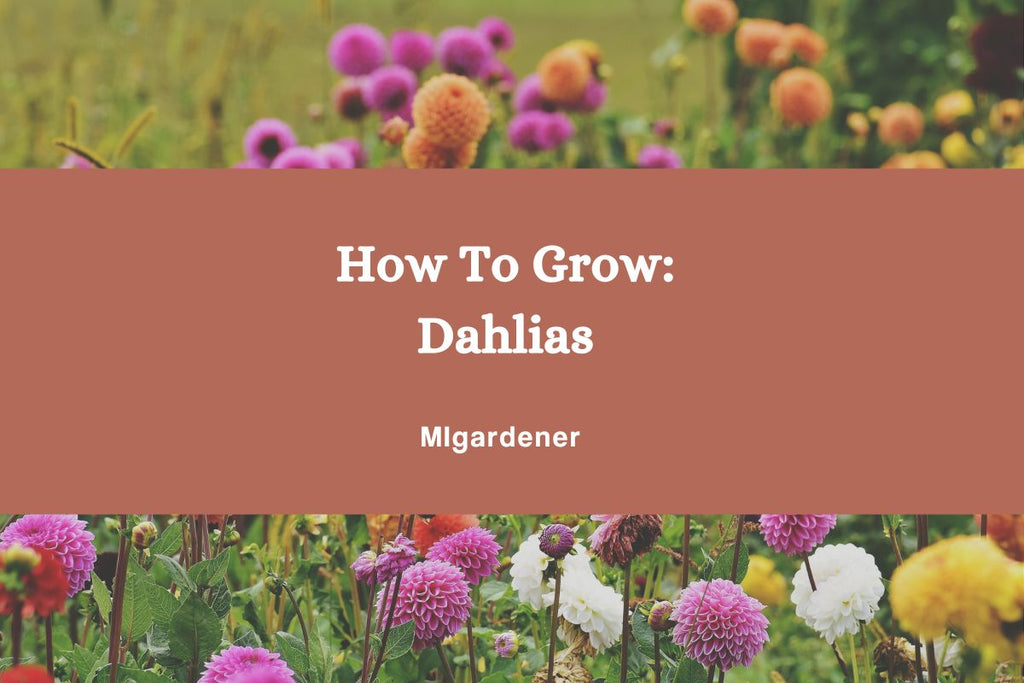
How to Grow Dahlias - Everyone's Favorite Cut Flower
When you think of a flower that everyone loves, you think of dahlias. They are the epitome of cottage garden beauty. Vases of them at cut flower stands are enough to make you fall in love with summer every year.

History of Dahlias
Dahlias are native to Central and South America, specifically the mountainous regions of Mexico and Guatemala. They were first discovered by Spanish explorers in the late 18th century, and were named in honor of Swedish botanist Anders Dahl.

The first recorded cultivation of dahlias was in the Botanical Gardens of Madrid, Spain in the early 1800s. From there, dahlias were introduced to other parts of Europe, and eventually made their way to North America.
In the early 19th century, dahlias became very popular among European gardeners, who began to hybridize and cultivate them for their beautiful blooms. This led to the development of a wide variety of dahlia cultivars, ranging in size from small pom-pom blooms to large dinner-plate blooms.

Did you know?!?
There are over 42,000 registered dahlia cultivars, with new cultivars being developed each year. These cultivars come in a wide range of colors, shapes, and sizes, and are classified into several different categories based on their flower form. Some of the most popular dahlia categories include:
-
Decorative "dinner plate" dahlias: Larger than life, fully double blooms with flat or slightly curled petals.
-
Cactus dahlias: Narrow, pointed petals that curve backward from the center of the flower.

-
Pompon dahlias: Small, ball-shaped blooms with tightly packed petals.

-
Anemone dahlias: A central cluster of tubular florets surrounded by one or more rings of flat petals.
-
Single dahlias: A single row of petals surrounding a central disk of small florets.
-
Waterlily dahlias: Fully double blooms with broad, flat petals that are often crinkled or twisted.
-
Fimbriated dahlias: Petals that are split or fringed at the tips

How to grow Dahlias
Location
Dahlias thrive in full sun and well-draining soil. Make sure to choose a location that receives at least six hours of sunlight per day. Additionally, make sure that the soil is well-draining, as dahlias do not like to be waterlogged. If you have heavy clay soil, consider adding compost or sand to improve drainage.
Planting
Dahlias can be planted from seed, or from tubers. If starting from seed, start seeds 8-12 weeks before your last frost date. Start them in good well draining mix with lots of light. If you are planting tubers, they are planted in the spring, after the last frost has passed. Dahlias will not tolerate any frost, so ensure the weather is warm enough. Make sure to plant the tubers at a depth of around 6 inches, and space them around 18 inches apart. If you are planting multiple rows, space the rows around 3 feet apart.

Water and fertilize
Dahlias need to be watered regularly, especially during the hot summer months. Because they form tubers, this requires tremendous amounts of energy and water to form. Make sure to water them deeply at least once a week, and more frequently during hot and dry periods. Additionally, fertilize your dahlias regularly with a balanced fertilizer to promote healthy growth and vibrant blooms. We use Trifecta+ with amazing success, but use whichever balanced fertilizer you trust.
Provide support! ***VERY IMPORTANT***
As dahlias grow, they will become top-heavy and require support to prevent them from bending or breaking. Stake your dahlias with bamboo canes or other support structures, making sure to do so early in the growing season.

Deadheading
Dahlias produce a lot of blooms, but these blooms do not last forever. Deadheading your dahlias regularly will promote the growth of new blooms and prevent the plant from putting energy into producing seeds. Simply snip off the spent blooms with a pair of shears or scissors.
Overwintering
Dahlias are not cold-hardy and need to be protected during the winter months. After the first frost, dig up your dahlias and store them in a cool, dry place. Make sure to cut back the foliage to the ground. Dig the plant up like a potato and gently brush off any soil. Clip tubers from the root system being very careful to not damage the "eyes" which grow very close to the main stem. Store the tubers in peat moss, sand or vermiculite and keep them damp at all times but not soaking and a place where the temperature stays around 40-50 degrees Fahrenheit.




Question??? I’m in zone 9 Deep South Louisiana. Do Dahlias like our heat & humidity?
If they are stored in sawdust, wood shavings, or peet, how does one keep them damp over the winter?
I am preparing to plant dahlia tubers, how much Trifecta+ should I use when initially planting? And then how often should I reapply?
Live in western Ky do I have to dig up in fall or can I cover with extra peat and compost and remove in spring???
Mine over winter with no problem in Southern CT
Leave a comment